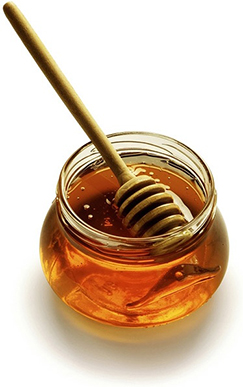
| Jan. 2017 | |||||||||||
| Top stories | |||||||||||
| In the news | |||||||||||
| Photos | |||||||||||
| Contact us | |||||||||||
| Archive | |||||||||||
|
All-natural honey may have traces of glyphosate |
Jan. 31, 2017 --
The "all-natural" honey marketed and sold in some Midwestern stores may not be all natural, after all, according to a testing method validated by the State Hygienic Laboratory.

Tests conducted at the lab in Coralville show even honey labeled "pure" contains residues of glyphosate, an ingredient in Monsanto's Roundup. The herbicide is the world's most common weed-killer, with widespread use particularly in agricultural fields in the Midwest.
"The bee farmers are throwing their hands in the air because they're not using glyphosate on their fields," said Dr. John Vargo, environmental lab scientist. "But the bees don't know where the property lines are."
Vargo said bees that forage in nearby fields where farmers use the herbicide can bring glyphosate back to the hives where the honey is made.
Bees can fly two miles or more from their hives to forage for nectar and pollen.
Unlike neonicotinoid insecticides used to treat corn and soybean crops that are considered highly toxic to bees, glyphosate is not thought to contribute to colony collapse disorder, which has decimated bee populations. Still, the findings have raised concerns.
Levels of up to 650 parts per billion were found in the honey tested by the Hygienic Lab, with 10 of 11 samples of products from Iowa, Minnesota, Kansas and Colorado all having detectable amounts of glyphosate.
"I don't think you're going to find any honey samples in the Midwest that don't have some level of glyphosate present," Vargo said.
The U.S. Environmental Protection Agency has not established any tolerance levels for glyphosate in honey because the chemical is not used in honey production. The European Union has set a maximum tolerance level in honey at 50 parts per billion.
Environmental and consumer advocates who point to the herbicide's reported link to cancer are contesting labeling by an Iowa honey producer as “all natural” on products that may contain the pesticide.
Vargo was asked by a former colleague to have the Iowa lab conduct an independent validation of the Food and Drug Administration method that was developed to test honey.
This method uses a highly sensitive and highly specific technique known as liquid chromatography/tandem quadrupole mass spectrometry (LCMSMS). The Hygienic Lab successfully validated the FDA method early in 2016 and additionally tested some honey samples obtained from local grocery stores.
Vargo co-authored a paper last summer with FDA chemist Narong Chamkasem that cited the findings and is included in the FDA's Laboratory Information Bulletin used for the rapid dissemination of laboratory methods (LIB 4613).
In 2015, a World Health Organization agency declared glyphosate a “probable human carcinogen,” but Vargo said product tests have not shown a definitive link between intermediate amounts of glyphosate exposure and human cancer; therefore, the amount of honey consumed in a typical diet likely would not be a concern.
"There are contaminants in everything we eat and drink," he said, citing that many can be detected by highly sensitive equipment, including those used at the Hygienic Laboratory. These pollutants may have gone undetected 20 or 30 years ago because equipment used at that time was not sensitive enough to detect the contaminants.
The Hygienic Laboratory routinely tests for glyphosate in drinking and surface water, as well as in pesticide spray drift, and is one of a small number of labs in the nation to test for glyphosate in honey.
At this time, honey is the only food the lab tests for glyphosate; a demand for testing of other foods could be on the horizon.
"Tests like the ones we're doing demonstrate that a pesticide is getting in the food chain, and it's not supposed to be in there," Vargo said. "It raises the question, ‘If glyphosate is found in honey, where it's not supposed to be, where else might it be present?’"